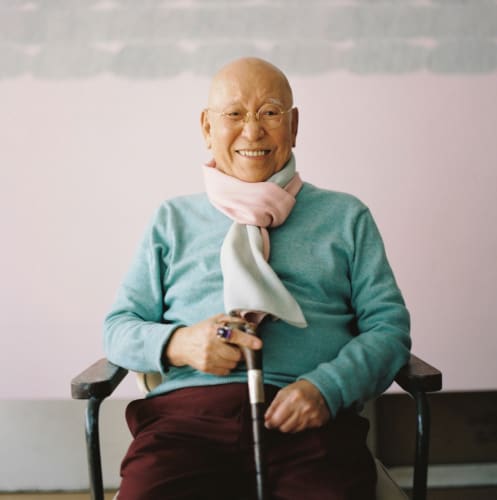Park Seo-Bo, a key figure in South Korea’s Dansaekhwa Movement, has died at the age of 91. The artist died of lung cancer, a South Korean news agency reported Sunday.
Park revealed his advanced diagnosis and decision to not seek treatment in February 2022. His gallery, Perrotin, confirmed the news, writing “[Park] saw painting and the repetitive gesture from which his monochromes emerged as a catharsis.”
Park came onto the art scene in the late 1950s, as part of an avant-garde movement of young Korean artists that emerged during a period of political upheaval. Park first presented his work in New York in 1957, as part of an exhibition of contemporary Korean art. That showcase put Park and the little-known Korean art scene on the map internationally.
Born in 1931 in North Gyeongsang, a Japanese-occupied region of South Korea, to a family of eight children, he pursued training in traditional painting at Hongik University in Seoul. In 1950, his education was interrupted when he was drafted to serve in the Korean War.
“There was no food, no job opportunity, everything had gone back to ashes; all conventional values and ideas were laid naked and bare.” the artist said in a 2008 interview with the New York Times about the affects of war on him and his peers. He looked at painting as self-referential. “For me, painting has become a mere tool and method to cleanse and purify myself,” he said.
In 1961, Park landed a residency program in Paris and a UNESCO-funded scholarship aimed at bringing emerging Korean artists to Europe. That same year, in Korea, Park Chung Hee seized power in a military coup.
Embedded partially in the Paris scene, by 1965, Park went on to become a leading player behind the Korean Informel movement, when Korea-born artists sought to challenge a style of painting that was heavily influenced by Western artists. Their work also sought to push back against how the Japanese occupation shifted art and media in Korea. Park, like other Dansaekwa artists, abstracted his canvases with gestural brush strokes using neutral palettes, often producing monochromatic works.
Though considered a forefather in Korean contemporary art, Park has more recently attracted scrutiny from a younger generation. In May, South Korea’s Gwangju Biennale, considered for years to be Asia’s top biennial, ended an art prize funded by Park Seo-bo less than two years after it was founded. Detractors said that Park’s work, which lacks political content, was not suited to Gwanju, which was “founded in 1995 in memory of spirits of civil uprising of the 1980 repression of the Gwangju Democratization Movement,” according to the Biennale’s website. Further, they accused him of “remaining silent” and “conforming” to the anti-democratic regime in the 1960s and 1970s.
In response, Park, who was a major donor to the Gwanju Biennale, described the claims as factually inaccurate and called for more funding to be distributed to artists in Korea. “It is more progressive to create an environment in which second and third awards can be created,” he wrote. It was not the only support Park sought to bring to the arts scene in his country as he aged. A museum in his name is scheduled to open in next summer in Seogwipo on Korea’s Jeju Island.
Despite the criticism, Park has remained a highly influential figure in Korean art. In 2021, Alexandra Munroe, the Guggenheim Museum’s senior curator for Asian art, described him as a “towering figure” in Korean culture in a profile for the Times. In a statement, the New York gallerist Tina Kim, who focuses on contemporary Korean art, said Park’s mark on the art scene of his home country was invaluable. “[We] will miss his dynamism and energy, his unmatched charisma and commitment to Korean art.”
Park is survived by his wife and three children. A representative for the Park Seo-Bo Foundation did not immediately respond to ARTnews’s request for comment.

